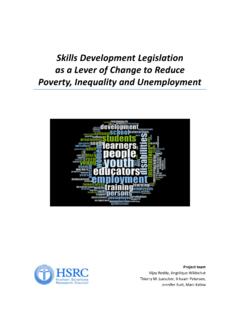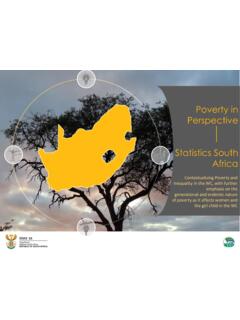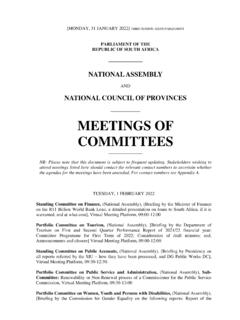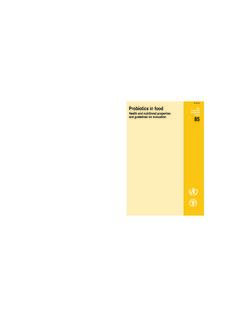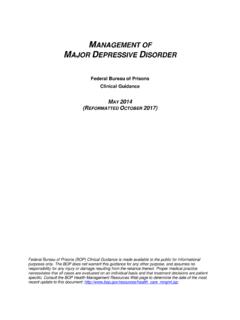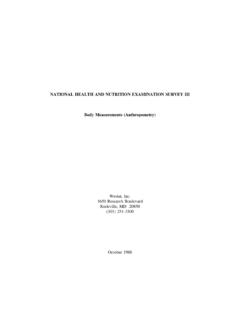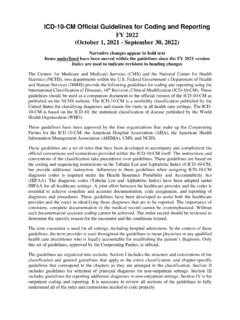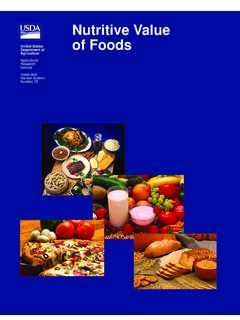Transcription of Access to quality health care in South Africa: Is the ...
1 Access to quality health care in South Africa: Is the health sector contributing to addressing the inequality challenge? Prepared by: Di McIntyre and John Ataguba, health Economics Unit, University of Cape Town Table of contents 1. 1 2. Towards conceptual clarity .. 1 Access to health services .. 1 quality of health services .. 2 Inequality and inequity .. 2 3. Introduction to assessment of South African health system and legislation .. 2 4. health status in South Africa .. 3 5. Current situation in terms of equitable Access to quality health services in South Africa .. 7 Service utilisation in South Africa .. 7 Key policy issues from evidence on health service utilisation .. 10 Access to health services in South 10 Information on the availability of health 11 Information on the affordability of health services .. 16 Information on the acceptability of health services .. 21 quality of health services in South Africa .. 22 Overview of key issues in terms of equitable Access to quality health services.
2 25 6. Reform options and their potential to address inequitable Access to quality health services in South Africa .. 26 Brief overview of key health sector reform proposals since 1994 .. 26 What is the goal of current reform proposals? .. 27 National health Insurance (NHI) reform proposals .. 28 Addressing inequalities in the allocation of public sector financial resources .. 29 Promoting efficient provision of quality services .. 30 Organisational arrangements including the roles of existing health departments33 Will the NHI be affordable and sustainable? .. 34 Funding of the NHI .. 36 NHIF organisational and governance imperatives .. 37 NHI and the role of medical schemes .. 39 The multi-payer mandatory medical scheme membership/SHI alternative to the NHI 40 Have any alternatives to NHI or SHI been put forward? .. 43 7. Recommendations .. 44 Annex 1: Glossary of relevant terms .. 49 Annex 2: Further details on conceptual issues .. 52 Access to health services.
3 52 quality of health services .. 53 Inequality and inequity .. 55 Annex 3: Summary of key health legislation since 57 Annex 4: Trends in mortality rates for different causes of death 1980-2015 .. 60 Annex 5: Utilisation data and its limitations .. 77 Annex 6: Key international experience relevant to current SA debates .. 78 Annex 7: Overview of strategic purchasing .. 80 1 1. Introduction This paper provides input to the Sub-Committee on the Triple Challenges of Poverty, Unemployment and Inequality of the High Level Panel on the Assessment of key Legislation and the Acceleration of Fundamental Change. More specifically, it focuses on the challenge of unequal Access to quality health care. The terms of reference for this research specify that the focus should be on the health system. While there are many factors that influence health such as housing, Access to potable water and sanitation, educational status and income levels (termed social determinants of health ), these are outside the scope of this paper.
4 Given the focus of the Sub-Committee, there is also a specific emphasis in this paper on inequality in the health system. The paper begins by briefly reviewing some key concepts underlying the analysis presented in this paper. A brief overview of health status and the distribution of morbidity (ill- health ) and mortality (deaths) in South Africa is then provided; this provides insights into the need for health services. There is then a detailed analysis of the health system in South Africa, specifically from the perspective of Access to and utilisation of health services. This includes, where relevant, a review of health legislation introduced since 1994 in terms of its likely impact on addressing inequality in Access to quality health services. As the mandate of the High Level Panel is not only to take stock of the past performance of the South African legislative sector but also to ensure the continued advancement of the sector in executing its constitutional mandate , the paper then considers recent policy proposals to reform the South African health system, particularly the National health Insurance (NHI) proposals and alternative suggested approaches.
5 2. Towards conceptual clarity Annex 1 contains a glossary of terms of relevance to the issue of inequalities in Access to quality health care, and other terms used in the report that some readers may not be familiar with. This section briefly explores three concepts that are fundamental to the focus of this paper, namely Access , health service quality and inequality, with further detail about these concepts provided in Annex 2. Access to health services Access relates to the opportunity to obtain and appropriately use quality health services. It is concerned with the degree of fit or compatibility between the health system on the one hand and individuals who need to use these services on the other hand. Access is generally seen as being multidimensional or having different elements. In this paper, Access dimensions are summarised as: the availability (or physical Access ), affordability (or financial Access ) and acceptability (or cultural Access ) of health services1. The availability dimension of Access deals with whether the appropriate health services are available in the right place and at the right time to meet the needs of the population.
6 Affordability concerns the degree of fit between the full costs of using health care services and individuals ability-to- 1 McIntyre D, Thiede M, Birch S (2009). Access as a policy-relevant concept in low- and middle-income countries. health Economics, Policy and Law 4: 179-193. 2 pay in the context of the household budget and other demands on that budget. Acceptability is concerned with the fit between provider and patient attitudes towards and expectations of each other. Beliefs and perceptions also influence acceptability. quality of health services The most widely used definition of health care quality is that developed by the Institute of Medicine (IOM)2: "the degree to which health care services for individuals and populations increase the likelihood of desired health outcomes and are consistent with current professional knowledge." The IOM further indicates that quality health services should be: effective; efficient; equitable; patient centred; safe; and timely.
7 The UK National health Service (NHS) has also provided a helpful definition of quality of care, which they see as relating to three areas: clinical effectiveness, patient safety and patient experience 3. This could be further summarised as technical and interpersonal excellence. Inequality and inequity health inequalities are defined as differences in health status between groups within a country. Inequalities across groups are most frequently considered in terms of socioeconomic position, race, ethnicity, place of residence/geographic location, gender and age. From a health system perspective, inequalities similarly refer to differences across groups such as in Access to quality health care. The internationally accepted definitions of health system equity, in relation to financing and utilisation of health of services respectively, are: Payments towards funding of health services should be according to ability-to-pay (or income); and Use of health services should be according to need.
8 These definitions imply that an equitable health system will have both income and risk cross-subsidies. 3. Introduction to assessment of South African health system and legislation The government elected in the first democratic elections in 1994 inherited a highly fragmented health system, with separate public and private health sectors and a multiplicity of health departments in the public sector, including one for each of the 4 former provinces and 10 former homelands . While public sector health services had been officially desegregated in 1988, historically black health care facilities and the homelands health departments had been systematically underfunded during the apartheid era. For example, average per capita public sector health care expenditure was R55 in the homelands compared to an average of R172 in the rest of South Africa in the 1986/87 financial year4. Thus, the health system was not only fragmented, but had large disparities in resource distribution between geographic areas and between individual facilities within the public 2 Institute of Medicine (2001).
9 Crossing the quality Chasm: A New health System for the 21st Century. Washington, : National Academy Press. 3 Department of health (2008). High quality care for all: NHS next stage review final report. London: The Stationery Office. 4 McIntyre DE (1990). Public Sector health Care Expenditure in South Africa, 1970 - 1990. Cape Town: health Economics Unit, University of Cape Town. 3 sector. Although South Africa was already devoting a relatively large amount of resources to the health sector ( of GDP in 1992/93), it had very poor health status indicators relative to comparable middle-income countries, indicating poor use and distribution of available health care resources5. Since 1994, a range of legislation and policies has been introduced; an overview of the key health legislation is provided in Annex 3. In addition to the National health Act, which provides the legislative framework for the overall health system, several of the other Acts have focused on regulating different health professionals (establishing professional Councils to regulate training and take disciplinary action where necessary, introducing a year of compulsory community service, etc.)
10 , or on specific health issues such as unwanted pregnancies (Termination of Pregnancy Act), mental health and the control of tobacco products. Other significant legislation since 1994 relates to the re-regulation of medical schemes, the establishment of the National health Laboratory Service (NHLS) and taking steps to improve Access to medicines. Instead of considering each piece of legislation in detail and in isolation, the following sections consider issues around equitable Access to quality health services and make reference to relevant legislation, and its potential role in addressing the inherited health system challenges, as part of this assessment. Before presenting the health system assessment, a brief overview of current and recent trends in health status is provided; this provides insights into the need for health services in the South African context. 4. health status in South Africa After the first democratic elections, South Africa saw a rapid increase in annual registered deaths, rising from 317,727 in 1997 to a high of 614,014 in 2006.






